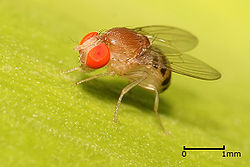Drosophilidae
| Drosophilidae | |
|---|---|
 |
|
| Drosophila sp. | |
| Scientific classification | |
| Kingdom: | Animalia |
| Phylum: | Arthropoda |
| Class: | Insecta |
| Order: | Diptera |
| Suborder: | Brachycera |
| Section: | Schizophora |
| Subsection: | Acalyptratae |
| Superfamily: | Ephydroidea |
| Family: |
Drosophilidae Róndani, 1856 |
| Subfamily | |
The Drosophilidae are a diverse, cosmopolitan family of flies, which includes fruit flies. Another unrelated family of flies, Tephritidae, also includes species known as "fruit flies". The best known species of the Drosophilidae is Drosophila melanogaster, within the genus Drosophila, and this species is used extensively for studies concerning genetics, development, physiology, ecology and behaviour. This fruit fly is mostly composed of post-mitotic cells, has a very short lifespan, and shows gradual aging. As in other species, temperature influences the life history of the animal. Several genes have been identified that can be manipulated to extend the lifespan of these insects.
Generally, drosophilids are considered to be nuisance flies rather than pests, since most species breed in rotting material. Zaprionus indianus Gupta is unusual among Drosophilidae species in being a serious, primary pest of at least one commercial fruit, figs in Brazil. Another species, Drosophila suzukii, infests thin-skinned fruit such as raspberries and cherries and can be a serious agricultural pest.Drosophila repleta larvae inhabit drains and spread bacteria. Fruit flies in general are considered as a common vector in propagating acetic acid bacteria in nature. This often ruins the alcohol fermentation process and can ruin beer or wine by turning it into vinegar.
The diagnostic characteristics for Drosophilidae include the presence of an incomplete , two breaks in the costal vein, a small anal cell in the wing, convergent postocellar bristles; and usually three frontal bristles on each side of the head, one directed forward and the other two directed rearward. More extensive identification characteristics can be found in "Drosophila: A Guide to Species Identification and Use" by Therese A. Markow and Patrick O'Grady, (Academic Press, 2005) or "Drosophila: A Laboratory Handbook" by M. Ashburner, K. Golic, S. Hawley, (Cold Spring Harbor Laboratory Press, 2005).
...
Wikipedia
